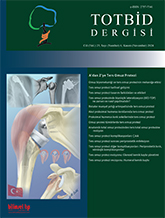
The proximal humerus is a region where both primary and secondary malignancies are common. However, it is a joint prone to instability where dynamic and static stabilizers work together. Therefore, obtaining a functional shoulder after large masses requiring bone and soft tissue resection also brings technical difficulties. Although various surgical procedures have been tried from past to present, in recent years, reconstruction with anatomical mega endoprostheses after resection has become almost a routine. However, in cases where the muscle structures required for the prosthesis to sustain functionally must be removed along with the mass, these prostheses act as spacers and the functional results of the patients are mostly poor. The biomechanical advantages of the reverse shoulder prosthesis, which is routinely applied in rotator cuff arthropathies in elderly patients, have recently become widespread in its use after oncological surgeries.
There is no consensus yet regarding the indications or contraindications for reverse shoulder prosthesis, which is still new to use in oncological shoulder surgeries and has insufficient long-term results. In this article, issues such as the use of reverse shoulder prosthesis after proximal humerus masses, points to be considered in surgery, and comparison with other reconstruction options will be discussed in the light of literature data.